英语语言学概论semantics
- 格式:doc
- 大小:88.50 KB
- 文档页数:11

Chapter 5 Semantics 语义学一、定义1. semantics语义学:Semantics can be simply defined as the study of meaning in language.语义学可以简单地定义为对意义的将研究。
二、知识点5.2 Different views of meaning意义研究的不同观点5.2.1 The naming theory命名论(by希腊Scholar Plato)The naming theory命名论:Words are just names or labels for things.词语只不过是其代表的事物的名字或标记。
Eg. desk—a piece of furniture with a flat top and four legs.The limitations of this theory局限性:1. This theory seems applicable to nouns only.这一理论看起来仅适用于名词(Some words are definitelynot lables of object:eg. jump, quickly, pretty, and, in,hearted, think, hard, slowly…)2. There are nouns which denote things that do not exist in the real world:ghost, gragon, unicorn麒麟.有些名词是指世界中根本就不存在的事物。
3. Nouns that do not refer to physical object, but abstract notions such asjoy and impulse.有些名词并不是指实物性的物体,而是指:joy, impulse刺激,这样的抽象概念。
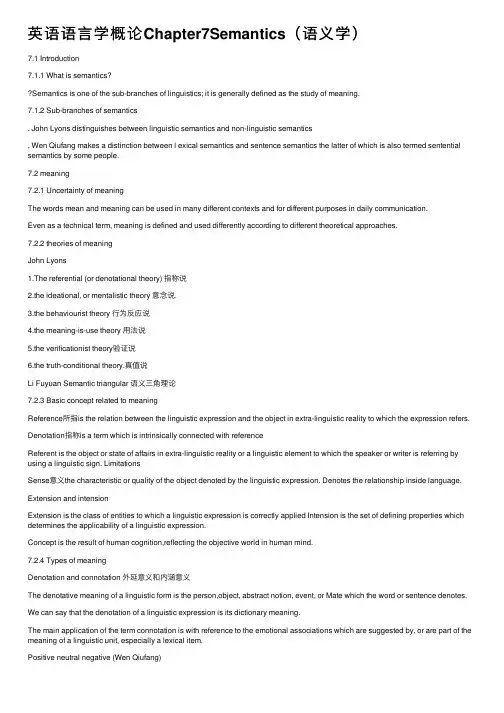
英语语⾔学概论Chapter7Semantics(语义学)7.1 Introduction7.1.1 What is semantics?Semantics is one of the sub-branches of linguistics; it is generally defined as the study of meaning.7.1.2 Sub-branches of semantics. John Lyons distinguishes between linguistic semantics and non-linguistic semantics, Wen Qiufang makes a distinction between l exical semantics and sentence semantics the latter of which is also termed sentential semantics by some people.7.2 meaning7.2.1 Uncertainty of meaningThe words mean and meaning can be used in many different contexts and for different purposes in daily communication.Even as a technical term, meaning is defined and used differently according to different theoretical approaches.7.2.2 theories of meaningJohn Lyons1.The referential (or denotational theory) 指称说2.the ideational, or mentalistic theory 意念说.3.the behaviourist theory ⾏为反应说4.the meaning-is-use theory ⽤法说5.the verificationist theory验证说6.the truth-conditional theory.真值说Li Fuyuan Semantic triangular 语义三⾓理论7.2.3 Basic concept related to meaningReference所指is the relation between the linguistic expression and the object in extra-linguistic reality to which the expression refers. Denotation指称is a term which is intrinsically connected with referenceReferent is the object or state of affairs in extra-linguistic reality or a linguistic element to which the speaker or writer is referring by using a linguistic sign. LimitationsSense意义the characteristic or quality of the object denoted by the linguistic expression. Denotes the relationship inside language. Extension and intensionExtension is the class of entities to which a linguistic expression is correctly applied Intension is the set of defining properties which determines the applicability of a linguistic expression.Concept is the result of human cognition,reflecting the objective world in human mind.7.2.4 Types of meaningDenotation and connotation 外延意义和内涵意义The denotative meaning of a linguistic form is the person,object, abstract notion, event, or Mate which the word or sentence denotes. We can say that the denotation of a linguistic expression is its dictionary meaning.The main application of the term connotation is with reference to the emotional associations which are suggested by, or are part of the meaning of a linguistic unit, especially a lexical item.Positive neutral negative (Wen Qiufang)7.3Lexical semantics is concerned with the meaning of lexical items.7.3.1 componential analysis成分分析The way to decompose the meaning of a word into its components is known as componential analysis. We can analyze a word as a set of semantic features or semantic components with the values: plus ( + ) or minus ( -)7.3.27.3.2 Semantic field 语义场Words do not exist in isolation. They are always related to each other in one another and form different semantic fields. Semantic field theory is a theory of the German structuralist school:the vocabulary of a language is not simply a listing of independent items, but is organized into areas, or fields, within which words interrelate and define each other in various ways. (Crystal. 1985, 274).7.3.3 Lexical relationsSaeed 8 lexical relations⼀Form relation 形式关系Homonymy同⾳(同形)异义关系two or more lexical items are synonyms when they have the same meaningsAbsolute homoyms 同⾳同形异义词Homopones 同⾳异义词Homographs 同形异义词⼆Sense relations 语义关系1.Polysemy⼀词多义关系 a lexical item has a range of different meanings2.Synonymy同义关系two or more lexical items have the same meanings3.Antonymy反义关系two words are opposite in meaningcomplementary antonymy 互补反义关系Gradable antonymy 等级反义关系Relational opposite 关系对⽴反义词4.Hyponymy下义关系Hyponym 下义词Hyperonym 上义词三object relations 实体关系1.Meronymy 组成部分与整体关系2.Member-collection 成员与集体关系3.Portion-mass 部分与整体关系Lexical ambiguity is caused by ambiguous words rather than by ambiguous structures and is usually created by polysemy or homonymy.7.4 sentential semanticsSix essential factors for determining sentence meaningi) the meanings of individual words which make up a sentence;ii) grammaticality of a sentence;iii) the linear ordering of the linguistic forms in a sentence;iv) the phonological features like stress and intonation;v) the hierarchical order of a sentence;vi) the semantic roles of the nouns in relation to the verb in a sentence.Nine semantic rolesAgent (施事格)Patient (⽬标格)Experiencer (经验者)Instrument (⼯具格)Cause (动因格)Attribute (属性)Recipient (接受者)Locative (⽅位格)Temporal (时间格)SynonymousEntailContradictPresuppose presupposition trigger TautologyContradictionSemantically anomalous 异常的反常的Predicate谓语argument论元proposition命题。
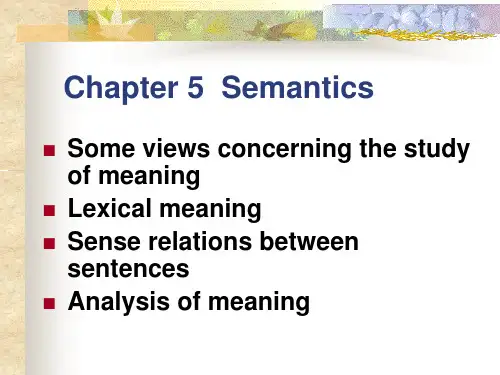
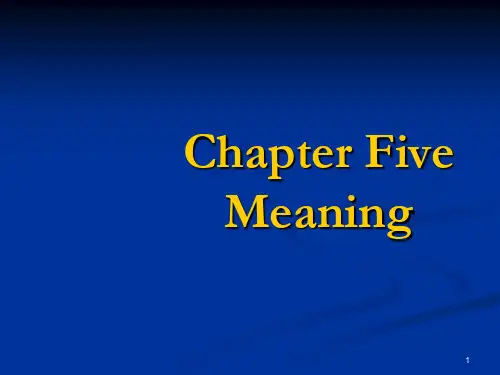
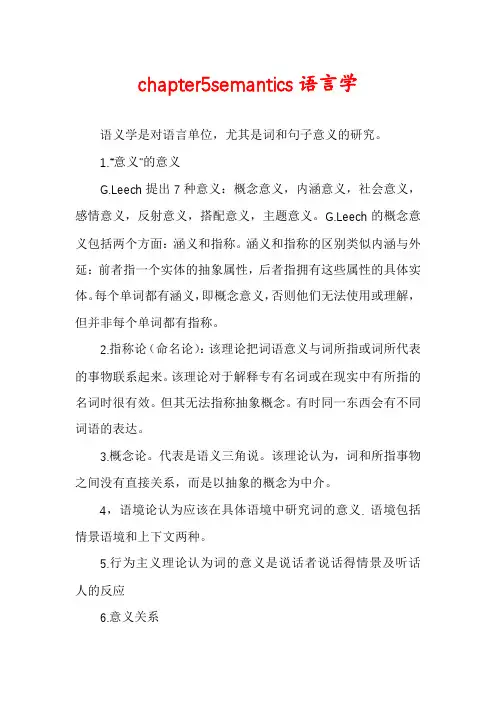
chapter5semantics语言学语义学是对语言单位,尤其是词和句子意义的研究。
1.“意义”的意义G.Leech提出7种意义:概念意义,内涵意义,社会意义,感情意义,反射意义,搭配意义,主题意义。
G.Leech的概念意义包括两个方面:涵义和指称。
涵义和指称的区别类似内涵与外延:前者指一个实体的抽象属性,后者指拥有这些属性的具体实体。
每个单词都有涵义,即概念意义,否则他们无法使用或理解,但并非每个单词都有指称。
2.指称论(命名论):该理论把词语意义与词所指或词所代表的事物联系起来。
该理论对于解释专有名词或在现实中有所指的名词时很有效。
但其无法指称抽象概念。
有时同一东西会有不同词语的表达。
3.概念论。
代表是语义三角说。
该理论认为,词和所指事物之间没有直接关系,而是以抽象的概念为中介。
4,语境论认为应该在具体语境中研究词的意义. 语境包括情景语境和上下文两种。
5.行为主义理论认为词的意义是说话者说话得情景及听话人的反应6.意义关系词语词之间的主要意义关系:相同关系,相反关系,包含关系a.同义关系。
完全同义关系很少,所谓的同一都依赖语境,并总在某方面不同。
(方言,内涵,文体等)b.反义关系主要包括:等级反义关系,互补反义关系,关系反义关系。
1)等级反义的特点:第一,否定一方并不必然是肯定另一方,还有中间状态;第二,没有绝对评判标准,标准随对象而改变。
第三,通常用其中表示较高程度的词来覆盖整个量级。
覆盖性词被称为“无标记的”,即一般性的;被覆盖词被称为“有标记的”,即特殊的。
一般使用覆盖性词语。
一旦使用被覆盖词语,表示有某种特殊的、不一般的情况。
第四,可用very修饰,可有比较级最高级2)互补反义关系,第一,肯定一方意味着否定另一方。
反之亦然。
第二,不用very修饰,没有比较级最高级。
第三,评判标准绝对。
没有覆盖性词语3)关系(反向)反义关系,表现两个实体间的一种反向关系,不构成肯否定对立。
一个预设着另一个的存在。
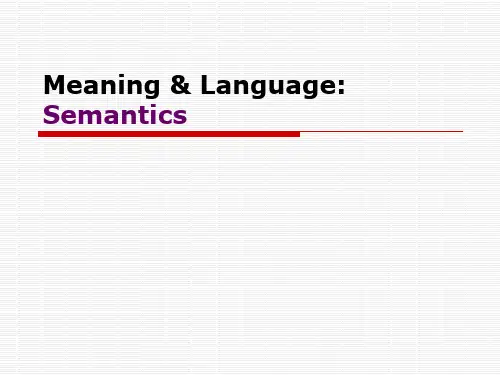
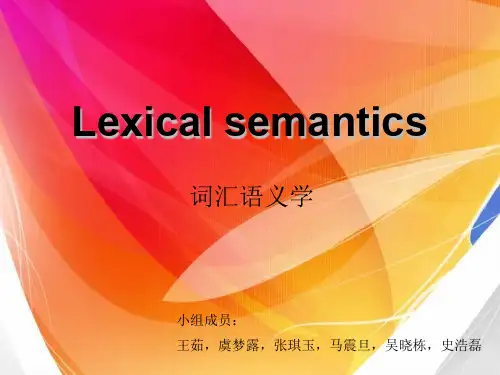
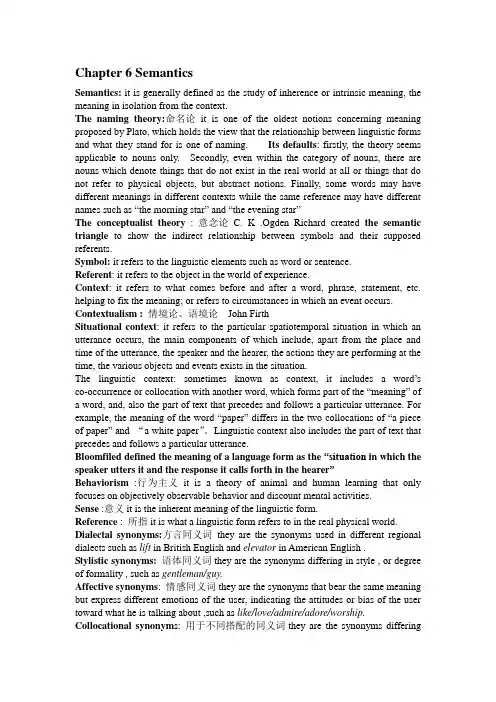
Chapter 6 SemanticsSemantics: it is generally defined as the study of inherence or intrinsic meaning, the meaning in isolation from the context.The naming theory:命名论it is one of the oldest notions concerning meaning proposed by Plato, which holds the view that the relationship between linguistic forms and what they stand for is one of naming. Its defaults: firstly, the theory seems applicable to nouns only. Secondly, even within the category of nouns, there are nouns which denote things that do not exist in the real world at all or things that do not refer to physical objects, but abstract notions. Finally, some words may have different meanings in different contexts while the same reference may have different names such as “the morning star” and “the evening star”The conceptualist theory: 意念论C. K .Ogden Richard created the semantic triangle to show the indirect relationship between symbols and their supposed referents.Symbol: it refers to the linguistic elements such as word or sentence.Referent: it refers to the object in the world of experience.Context: it refers to what comes before and after a word, phrase, statement, etc. helping to fix the meaning; or refers to circumstances in which an event occurs. Contextualism :情境论、语境论John FirthSituational context: it refers to the particular spatiotemporal situation in which an utterance occurs, the main components of which include, apart from the place and time of the utterance, the speaker and the hearer, the actions they are performing at the time, the various objects and events exists in the situation.The linguistic context: sometimes known as context, it includes a word’s co-occurrence or collocation with another word, which forms part of the “meaning” of a word, and, also the part of text that precedes and follows a particular utterance. For example, the meaning of the word “paper” differs in the two collocations of “a piece of paper” and“a white paper”。
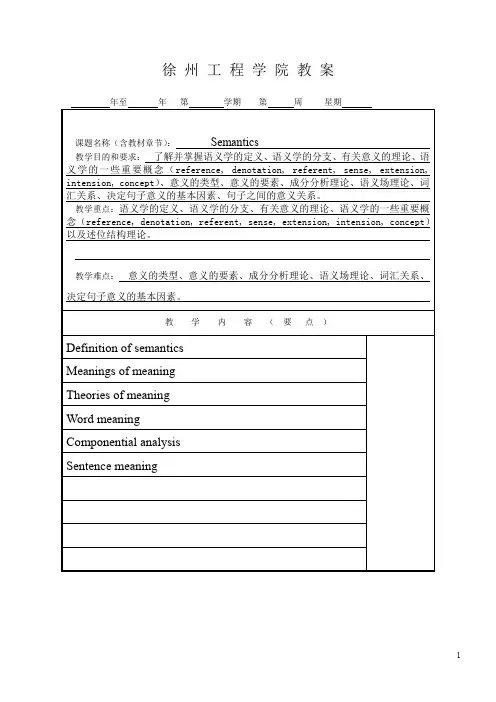
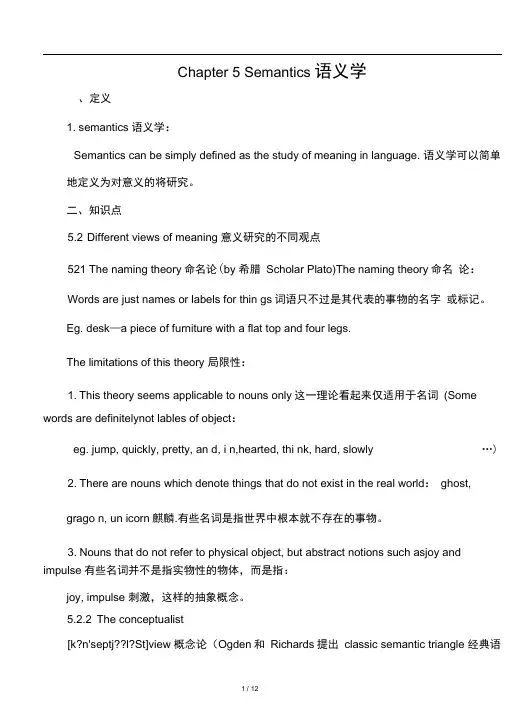
Chapter 5 Semantics 语义学、定义1. semantics 语义学:Semantics can be simply defined as the study of meaning in language. 语义学可以简单地定义为对意义的将研究。
二、知识点5.2 Different views of meaning 意义研究的不同观点521 The naming theory命名论(by 希腊Scholar Plato)The naming theory命名论:Words are just names or labels for thin gs词语只不过是其代表的事物的名字或标记。
Eg. desk—a piece of furniture with a flat top and four legs.The limitations of this theory 局限性:1. This theory seems applicable to nouns only这一理论看起来仅适用于名词(Some words are definitelynot lables of object:eg. jump, quickly, pretty, an d, i n,hearted, thi nk, hard, slowly …)2. There are nouns which denote things that do not exist in the real world: ghost,grago n, un icorn麒麟.有些名词是指世界中根本就不存在的事物。
3. Nouns that do not refer to physical object, but abstract notions such asjoy and impulse有些名词并不是指实物性的物体,而是指:joy, impulse 刺激,这样的抽象概念。
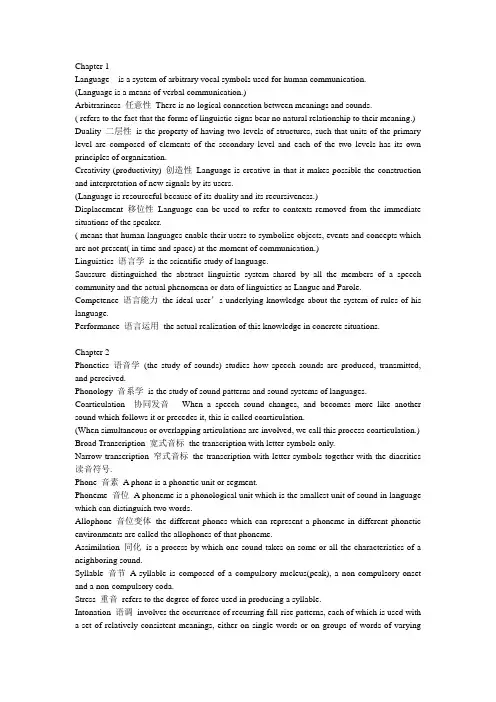
Language is a system of arbitrary vocal symbols used for human communication. (Language is a means of verbal communication.)Arbitrariness 任意性There is no logical connection between meanings and sounds.( refers to the fact that the forms of linguistic signs bear no natural relationship to their meaning.) Duality 二层性is the property of having two levels of structures, such that units of the primary level are composed of elements of the secondary level and each of the two levels has its own principles of organization.Creativity (productivity) 创造性Language is creative in that it makes possible the construction and interpretation of new signals by its users.(Language is resourceful because of its duality and its recursiveness.)Displacement 移位性Language can be used to refer to contexts removed from the immediate situations of the speaker.( means that human languages enable their users to symbolize objects, events and concepts which are not present( in time and space) at the moment of communication.)Linguistics 语言学is the scientific study of language.Saussure distinguished the abstract linguistic system shared by all the members of a speech community and the actual phenomena or data of linguistics as Langue and Parole. Competence 语言能力the ideal user’s underlying knowledge about the system of rules of his language.Performance 语言运用the actual realization of this knowledge in concrete situations.Chapter 2Phonetics 语音学(the study of sounds) studies how speech sounds are produced, transmitted, and perceived.Phonology 音系学is the study of sound patterns and sound systems of languages. Coarticulation 协同发音When a speech sound changes, and becomes more like another sound which follows it or precedes it, this is called coarticulation.(When simultaneous or overlapping articulations are involved, we call this process coarticulation.) Broad Transcription 宽式音标the transcription with letter-symbols only.Narrow transcription 窄式音标the transcription with letter-symbols together with the diacritics 读音符号.Phone 音素A phone is a phonetic unit or segment.Phoneme 音位A phoneme is a phonological unit which is the smallest unit of sound in language which can distinguish two words.Allophone 音位变体the different phones which can represent a phoneme in different phonetic environments are called the allophones of that phoneme.Assimilation 同化is a process by which one sound takes on some or all the characteristics of a neighboring sound.Syllable 音节A syllable is composed of a compulsory nucleus(peak), a non-compulsory onset and a non-compulsory coda.Stress 重音refers to the degree of force used in producing a syllable.Intonation 语调involves the occurrence of recurring fall-rise patterns, each of which is used with a set of relatively consistent meanings, either on single words or on groups of words of varyingChapter 3Morpheme 词素is the smallest meaning minimal meaningful units in a language. (Morpheme is the smallest unit of language in terms of the relationship between expression and content, a unit that cannot be divided into further smaller units without destroying or drastically altering the meaning, whether it is lexical or grammatical.)Morphology 形态学studies the internal structure of words, and the rules by which words are formed.Free morphemes 自由音素those that may occur alone, that is those which may constitute words by themselves.Bound morphemes 黏着音素those must appear with at least another morpheme, that is, they cannot stand alone.Root 词根is the base form of a word that cannot be further analyzed without destroying its meaning.Affixes 词缀forms that are attached to words or word elements to modify meaning or function. (is a collective term for the type of morpheme that can be used only when added to another morpheme (the root or stem), so affix is naturally bound.Stem 词干is any morpheme or combination of morphemes to which an inflectional affix can be added.Inflection indicates grammatical relations by adding inflectional affixes, such as number, person, finiteness, aspect and case. It will not change the grammatical class of the stem to which it is attached.Word formation refers to the process of how words are formed.Compounding 复合法the formation of new words by joining two or more stems.(The term compound refers to those words that consist of more than one lexical morpheme, or the way to join two separate words to produce a single form.)Derivation (affixation) 派生法the formation of words by adding derivational affixes to stems. ConversionChapter 4Syntax is the study of the rules governing the ways different constituents are combined to form sentences in a language, or the study of the interrelationships between elements in sentence structures.Syntax is the study of the formation of sentences.Syntactic relations can be analysed into three kinds, namely, positional relations, relations of substitutability, and the relations of co-occurrence 同现关系.Positional relation (word order) 位置关系refers to the sequential arrangement of words in a language. The sequential arrangement of words can either be well-formed or ill-formed (ungrammatical or nonsensical).Relations of substitutability 可替换关系Firstly, it refers to classes or sets of words substitutable for each other grammatically in sentences with the same structure. Secondly, it refers to groups ofmore than one word which may be jointly substitutable grammatically for a single word of a particular set.Grammatical construction/construct 语法结构can be used to mean any syntactic construct which is assigned one or more conventional functions in a language, together with whatever is linguistically conventionalized about its contribution to the meaning or use the construct contains. - Constituents are the components within one sentence (a term used for every linguistic unit, which is a part of a larger unit).Immediate constituents 直接成分are constituents immediately, or directly, below the level of a construction, which may be a sentence, a word group or even a word (which can be further analyzed into morphemes).Endocentric construction 向心结构is one whose distribution is functionally equivalent to that of one or more of its constituents, i.e., a word or a group of words, which serves as a definable center or head.Exocentric construction 离心结构refers to a group of syntactically related words where none of the words is functionally equivalent to the group as a whole, that is, there is no definable center or head.- Subject refers to one of the nouns in the nominative case.- Object Traditionally, subject can be defined as the doer of an action (the agent), then object m ay refer to the “receiver” or “goal” of the action (the patient), and it is further classified into Direct Object and Indirect Object.PS rules provide explanations on how syntactic categories are formed and sentences generated.Chapter 5Semantics is the study of meaning, or more specifically, the study of the meaning of linguistic units, words and sentences in particular.Referential theory 指称论The theory of meaning which relates the meaning of a word to the thing it refers to, or stand for, is known as the referential theory.- Reference is the relation by which a word picks out or identifies an entity in the world.Chapter 8Pragmatics 语用学Speaker’s meaning (utterance or contextual meaning) –the interpretation of a sentence depends on who the speaker is, who the hearer is, when and where it is used. In a word, it depends on the context. The discipline which concentrates on this kind of meaning is called pragmatics.Locutionary Act 发话行为(以言指事)When we speak we move our vocal organs and produce a number of sounds, organized in a certain way and with a certain meaning. The act performed in this sense is called a locutionary act.Illocutionary act 行事行为(以言行事)When we speak, we not only produce some units of language with certain meaning (locution), but also make our purpose in producing them, the way we intend them to be understood. This is the second sense in which to say something is to do something, and the act performed is known as an illocutionary act.Perlocutionary act 取效行为(以言成事)- It refers to the consequential effects of a locution upon the hearer.By telling somebody something the speaker may change the opinion of the hearer on something,or mislead him, or surprise him, or induce his to do something, etc.- Whether or not these effects are intended by the speaker, they can be regarded as part of the act that the speaker has performed.。
语义学一.语义学(Semantics)的定义:研究语言单位的意义,尤其是词语和句子的意义。
二.词汇意义(Lexical Meaning):1)意义与指称(sense and reference):意义与指称是语言研究中的两个术语,它们之间既相互联系,又相互区别。
意义(sense)是一系列抽象语义特征的集合,与语境无关,可以在字典中查到。
而指称(reference)是语言形式在现实物质世界中所指的事物;它涉及语言形式与非语言的现实世界之间的关系。
意义与指称是意义的两个相关但不同的方面,例如“morning star”和“evening star”的意义虽然不同,但其指称一样,都指代天空中的同一颗星星。
2)外延意义(denotative meaning):指词语所指称的外部世界的事物、状态、抽象情感。
例如:dog(狗)的外延意义是指“一种四肢、有毛、会汪汪叫的”,这种意义在任何国家、任何时代都不会改变。
3)内涵意义(connotative meaning):指源于语言使用者的个人经历、情感、评价、语境等外部因素的意义。
例如dragon一词,在汉语文化中象征着“高贵”、“权利”,但在某些英语国家文化中,其内涵意义则为“残暴”和“邪恶”。
三.意义关系(Sense Relationship):1)同义关系(Synonymy):方言同义词(Dialectal synonyms):意义相同但方言有差异的词,例如:autumn(BrE)= fall(ArE)。
文体同义词(Stylistic synonyms):意义相同但在文体上或者正式程度上有差别的词,例如:buy(较为随意)—— purchase(较为正式)。
搭配同义词(Collocational synonyms):指意义上相同,但是搭配不相同的词。
例如:provide和supply,provide sth. for sb.和supply sth. to sb.在情感或评价意义方面存在差异的同义词(Synonyms with different emotive or evaluative meaning):意义相同,但在情感或评价意义方面存在差异的词,例如:politician(政客)含贬义色彩,statesmen(政治家)含褒义色彩。
semantics含义和举例
Semantics是一个英语词汇,指的是语言学和逻辑学中与词义、句义以及语言表达的意义相关的概念和研究领域。
在语言学中,semantics研究词汇和句子的意义,并探讨词汇和句子之间的
关系。
在逻辑学中,semantics研究命题、谓词和推理等的意
义和语义逻辑。
举例:
1. 在语言学中,semantics可以用来解释词汇的意义。
比如,
英语单词"dog"的semantics是指代一种四肢的、长尾巴的、被
驯化且以人类为主要伙伴的哺乳动物。
2. 在逻辑学中,semantics可以用来解释谓词和推理的意义。
例如,谓词"是母亲"的semantics可以定义为"对于一个人x,
如果存在一个人y,y是x的孩子,则x是母亲"。
3. 在计算机科学中,semantics可以用来解释编程语言的意义。
比如,当编写一个计算两个数之和的程序时,semantics可以
定义为将两个数相加并返回结果的操作。
总而言之,semantics的含义涵盖了语言学、逻辑学和计算机
科学等多个学科领域。
它帮助我们理解和研究词汇、句子、命题以及计算机程序等的意义和语义关系。